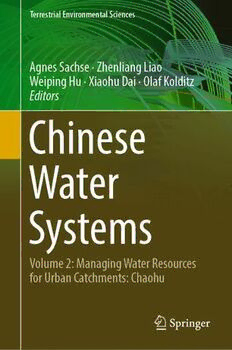
Chinese Water Systems: Volume 2: Managing Water Resources for Urban Catchments: Chaohu PDF
Preview Chinese Water Systems: Volume 2: Managing Water Resources for Urban Catchments: Chaohu
Terrestrial Environmental Sciences Agnes Sachse · Zhenliang Liao Weiping Hu · Xiaohu Dai · Olaf Kolditz Editors Chinese Water Systems Volume 2: Managing Water Resources for Urban Catchments: Chaohu Terrestrial Environmental Sciences Series editors Olaf Kolditz Hua Shao Wenqing Wang Uwe-Jens Görke Sebastian Bauer More information about this series at http://www.springer.com/series/13468 Agnes Sachse Zhenliang Liao (cid:129) Weiping Hu Xiaohu Dai Olaf Kolditz (cid:129) (cid:129) Editors Chinese Water Systems Volume 2: Managing Water Resources for Urban Catchments: Chaohu 123 Editors Agnes Sachse Xiaohu Dai OpenGeoSys e.V. Collegeof Environmental Science Leipzig, Germany andEngineering, UNEP-Tongji Institute of Environment Zhenliang Liao forSustainable Development Collegeof Environmental Science TongjiUniversity andEngineering, UNEP-Tongji Shanghai, China Institute of Environment forSustainable Development OlafKolditz TongjiUniversity Department ofEnvironmental Informatics Shanghai, China Helmholtz Centre for Environmental Research–UFZ Weiping Hu Leipzig, Germany ChineseAcademy of Sciences NanjingInstitute of Geography andLimnology Nanjing, China ISSN 2363-6181 ISSN 2363-619X (electronic) Terrestrial Environmental Sciences ISBN978-3-319-97567-2 ISBN978-3-319-97568-9 (eBook) https://doi.org/10.1007/978-3-319-97568-9 LibraryofCongressControlNumber:2018933479 ©SpringerNatureSwitzerlandAG2019 Thisworkissubjecttocopyright.AllrightsarereservedbythePublisher,whetherthewholeorpart of the material is concerned, specifically the rights of translation, reprinting, reuse of illustrations, recitation, broadcasting, reproduction on microfilms or in any other physical way, and transmission orinformationstorageandretrieval,electronicadaptation,computersoftware,orbysimilarordissimilar methodologynowknownorhereafterdeveloped. The use of general descriptive names, registered names, trademarks, service marks, etc. in this publicationdoesnotimply,evenintheabsenceofaspecificstatement,thatsuchnamesareexemptfrom therelevantprotectivelawsandregulationsandthereforefreeforgeneraluse. The publisher, the authors and the editors are safe to assume that the advice and information in this book are believed to be true and accurate at the date of publication. Neither the publisher nor the authorsortheeditorsgiveawarranty,expressorimplied,withrespecttothematerialcontainedhereinor for any errors or omissions that may have been made. The publisher remains neutral with regard to jurisdictionalclaimsinpublishedmapsandinstitutionalaffiliations. ThisSpringerimprintispublishedbytheregisteredcompanySpringerNatureSwitzerlandAG Theregisteredcompanyaddressis:Gewerbestrasse11,6330Cham,Switzerland Foreword China’s rapid economic development—coupled with strong population growth, increasing urbanization, and improved living standards—has led to an increasing burden on existing water resources in recent years. The supply and disposal structures were often unable to keep pace with growth, which among other things led to severe water pollution. Germany hasmasteredsimilar water pollutionchallenges initspast. Theuseof modern environmental protection technologies and sustainable water management has resulted in globally recognized quality in water protection and drinking water quality. Experiences fromtwodecadesofintensivecollaboration between research and industry can serve as an example for other nations to sustainably strengthen and improve environmental protection, especially in the area of vital aquatic ecosystems. Sustainable water research has now become an important topic in the emerging economic nation of China. The Urban Water Resource Management (UWRM)- projectpresentedherewasabletoanalyzethecurrentstateofaChineseurbanand lake catchment with its practically applied methods and models and present treat- ment options. It not only raises public awareness of the issue but also brings togethertherepresentativesofinternationalresearchinstitutes,localauthorities,and global companies. The existing German-Chinese cooperation in research and industry should also be further expanded in the future in order to work effectively with current solutions to environmental problems. WithinthisUWRM-project,theGermannonprofitassociationOpenGeoSyse.V. issupportingthecompilationofallprojectresultsinacompendium,andmakingit availabletoallinterestedparties.ThepurposeoftheOGSe.V.isthepromotionof science and research for computer-aided simulation in the environmental science and geotechnology. Those results often serve as a bridge to transfer knowledge between science, research, and the public. In addition, the association tries to v vi Foreword promoteothernationalnonprofitcorporationsinthefieldofscienceandresearchin idealandfinancialways.Thepurposeoftheassociationisachievedbycarryingout trainingcourses,publicitywork,advertising,andinparticularbytheproductionof visual material and publications like this book. Leipzig, Germany Thomas Kalbacher March 2018 Acknowledgements The project “Urban Catchments” is part of the German project cluster within the German-Chinese cooperation to the “Mega-Water Program” in China. It is funded by the Federal Ministry of Education and Research (BMBF) in the area of International Partnerships for Sustainable Technologies and Services for Climate Protection and the Environment (CLIENT) under the Research for Sustainable Development Framework Program. The funding under grant number 02WCL1337A-E is greatly acknowledged (Figs. 1 and 2). Fig.1 The“UrbanCatchments”-projectisfundedbyFederalMinistryofEducationandResearch ofGermany vii viii Acknowledgements Fig.2 Overviewofallprojectpartners Contents 1 Introduction . . . . . . . . . . . . . . . . . . . . . . . . . . . . . . . . . . . . . . . . . . . 1 Agnes Sachse, Zhenliang Liao, Weiping Hu, Xiaohu Dai and Olaf Kolditz 2 Managing Water Resources for Urban Catchments . . . . . . . . . . . . . 35 Olaf Kolditz, Thomas U. Berendonk, Cui Chen, Lothar Fuchs, Matthias Haase, Dirk Jungmann, Thomas Kalbacher, Peter Krebs, Christian Moldaenke, Roland Müller, Frank Neubert, Karsten Rink, Karsten Rinke, Agnes Sachse and Marc Walther 3 WP-A: Urban Water Resources Management . . . . . . . . . . . . . . . . . 87 Peter Krebs, Firas Al Janabi, Björn Helm, Honghao Li, Benjamin Wagner, Christian Koch, Renyuan Wang and Lothar Fuchs 4 WP-B: Development and Testing of a GIS-Based Planning Tool for Creating Decentralized Sanitation Scenarios. . . . . . . . . . . . . . . . 125 Thomas Aubron, Manfred van Afferden, Ganbaatar Khurelbaatar and Roland Müller 5 WP-C: A Step Towards Secured Drinking Water: Development of an Early Warning System for Lakes . . . . . . . . . . . . . . . . . . . . . . 159 Marcus Rybicki, Christian Moldaenke, Karsten Rinke, Hanno Dahlhaus, Knut Klingbeil, Peter L. Holtermann, Weiping Hu, Hong-Zhu Wang, Haijun Wang, Miao Liu, Jinge Zhu, Zeng Ye, Zhaoliang Peng, Bertram Boehrer, Dirk Jungmann, Thomas U. Berendonk, Olaf Kolditz and Marieke A. Frassl 6 WP-D: Environmental Information System . . . . . . . . . . . . . . . . . . . 207 Frank Neubert, Matthias Haase, Karsten Rink and Olaf Kolditz 7 WP-E: Groundwater Systems . . . . . . . . . . . . . . . . . . . . . . . . . . . . . . 231 Martin Pohl, Christian Engelmann and Marc Walther ix
